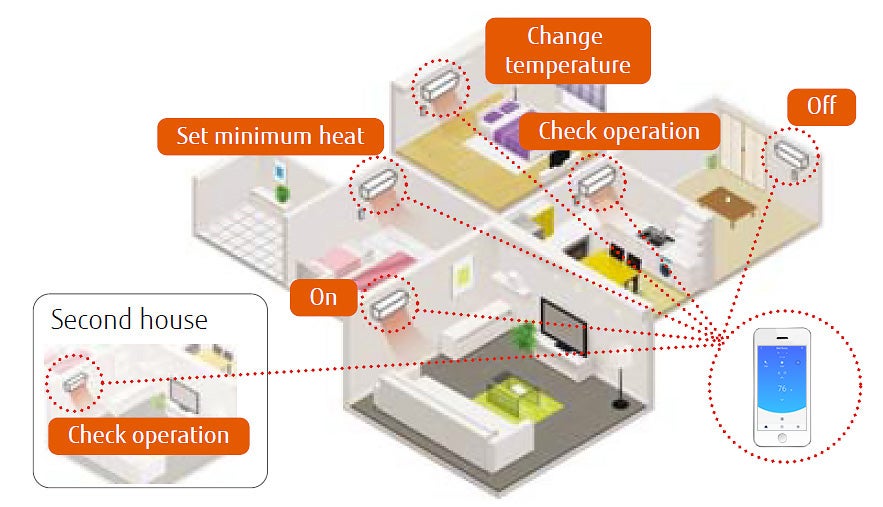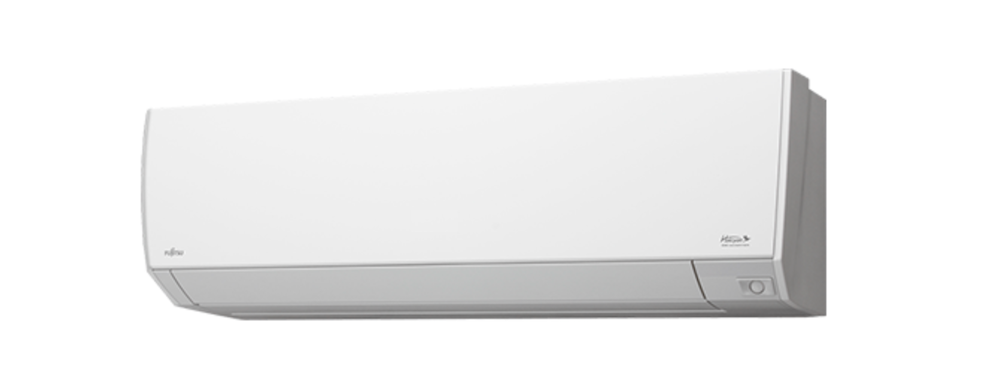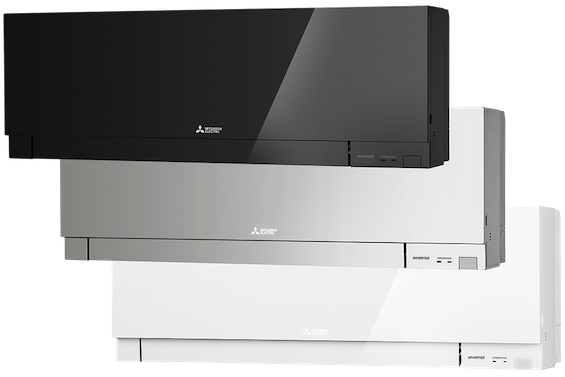Fujitsu offers everything homeowners want in a mini-split AC and heat pump brand, namely tons of options and warranty-backed reliability.
But are they worth buying, let alone competitive with Mitsubishi – the most popular mini-split brand in the U.S.?
Short answer: yes.
To secure more confidence in our answer, read on as we quickly explore Fujitsu's mini-split offerings, how much they cost, and whether you should consider them over Mitsubishi.
Get in touch with a local contractor today.
On this page
- Mini-split review
- Fujitsu mini-split types and costs
- How to pick a style
- Fujitsu vs. Mitsubishi
- Are they worth it?
A brief review of mini-splits
Mini-splits divide heating and cooling duties among at least one outdoor condenser and one indoor air handler. They connect via refrigerant lines.
This approach contrasts with traditional forced-air systems, like central air or heating, that consolidate all HVAC parts into a single unit.
Why choose mini-splits?
For starters, ductless mini-split systems eliminate the need for costly ductwork and make HVAC zoning easier.
Mini-split air conditioners and heat pumps also operate quieter and more efficiently than most existing central HVAC systems.
Fujitsu mini-split styles and costs
Fujitsu, officially Fujitsu General, offers a wide selection of air handler styles and capabilities under their Halcyon line to suit your home's distinct HVAC needs and your aesthetic preferences.
They include:
- Wall-mounted: exactly what it sounds like – an AC unit affixed to the wall
- Floor mounted: sits closer to the ground, ideal for rooms with little upper wall space like kitchens and sunrooms
- Compact cassette: recesses into the ceiling for extra discreet heating and cooling
- Cassette: larger than compact cassette, but offers more heating and cooling power
- Universal Floor/Ceiling: serves as either a ceiling or a floor unit
- Large Ceiling: high-capacity ceiling unit
- Slim duct: ducted mini-split with compact profile for versatility
- Medium static pressure duct: high-capacity ducted mini-split
| Buy from eComfort | Buy from HVACwholesalers | Buy from HVACDirect |
Fujitsu mini-split features
To give you control over your mini-split's operation, Fujitsu provides a range of control and communication accessories, including wired and wireless remotes.

Image source: Fujitsu
Some units even have Wi-Fi capabilities, which let you change settings from anywhere with an internet connection using your mobile device.
For increased efficiency, home comfort, and quiet operation, all models use inverter technology.
Other notable features across their lineup are their automatic multi-way fans and louvers. By constantly changing the airflow direction, these mini-splits help distribute air evenly across the room for better comfort.
Heat pumps under their Extra Low-Temperature Heating Series (XLTH) work in temperatures as low as -15 degrees Fahrenheit.
| Style | BTU/h Cooling | BTU/h Heating | SEER | Cost per unit (no install) |
| Wall-mounted | 9,000 - 33,000 | 10,000 - 34,000 | 16.0 - 33.1 | $1,155 - $4,531 |
| Floor-mounted | 9,000 - 14,200 | 12,000 - 18,000 | Up to 26.0 | $1,814 - $2,800 |
| Compact Cassette | 9,000 - 17,100 | 17,100 - 21,600 | Up to 24.0 | $2,032 - $3,072 |
| Cassette | 18,000 - 42,000 | 21,000 - 47,000 | 18.5 - 21.4 | $3,593 - $6,874 |
| Universal Floor/Ceiling | 17,800 - 22,200 | 21,500 - 24,000 | 16.0 | $2,813 - $3,509 |
| Large Ceiling | 34,100 | 36,500 | 16.0 | $3,968 |
Fujitsu ducted mini-splits breakdown
Fujitsu also makes ducted mini-split air-handling units – a comparably energy-efficient yet even more discreet way to cool your home using ductwork and air registers.
| Style | BTU/h Cooling | BTU/h Heating | SEER | Cost range |
| Slim Duct | 9,000 - 17,100 | 12,000 - 21,600 | 21.5 | $1,912 - $2,946 |
| Medium Static Pressure Duct | 12,000 - 48,000 | 16,000 - 53,000 | 16.6 - 21.3 | $2,628 - $6,855 |
Which mini-split style should I pick?
The most important thing is to match your equipment BTU per hour to the individual zone's heating and cooling needs.
Undersized air conditioners and heat pumps will never get their zone to your desired temperature. On the other hand, oversized equipment will short cycle – a bad thing for several reasons.
A Manual J Calculation performed by a licensed HVAC contractor will provide an appropriate BTU per hour estimate.
Once you know the right size, you can choose the mini-split styles that support that load.
Let's say you fancy Fujitsu's compact cassette mini-split for its incognito profile. As long as your zone calls for somewhere between 9,000 and 17,100 cooling BTUs per hour, that unit should work well.
You may also want to consider unit efficiency to secure lower lifetime electricity costs branded with a higher SEER number. Energy Star-certified systems can even net you a tax rebate of $300 as of this writing.
Fujitsu vs. Mitsubishi mini-splits
Performance
Winner: Fujitsu
Fujitsu and Mitsubishi go toe-to-toe in terms of mini-split sizing and efficiency.
At their most efficient, Fujitsu and Mitsubishi mini-split SEER ratings cap out at an extremely efficient 33.1.
Fujitsu mini-split heat pumps clock efficiency ratings as high as 14.2 HSPF. That's better than Mitsubishi, which only boasts up to 13.6 HSPF for their top-of-the-line heat pumps.
Eclipsing Mitsubishi further, only Fujitsu offers a 48,000 cooling BTU mini-split. Mitsubishi units don't exceed 42,000 BTUs. That's still more than enough for most situations, but Fujitsu has that extra power should you need it.
If we had to nitpick, Fujitsu just edges out Mitsubishi with their Extra Low-Temperature Heating Series of heat pumps, which can heat at -15 degrees Fahrenheit. Mitsubishi's best only work until -13.
In favor of Mitsubishi, their entry-level splits have a 17 SEER rating while Fujitsu's only have 16. It's a small difference but can make a significant dent in lifetime costs.
Pricing
Winner: Fujitsu
Although these rivals price themselves competitively, you'll likely spend less on Fujitsu products.
Just looking at their entry-level, 9,000 BTU wall-mounted mini-splits, the unit price difference comes out to less than $100 in favor of Fujitsu.
Price disparities exceed $1,000 when shopping for each brand's highest capacity mini-splits, with Fujitsu proving to be the more affordable option.
Although Fujitsu wins out in the head-to-head, it may not mean much in reality.
Pricing gets far more complex when comparing multi-zone cooling and heating systems. Depending on how you configure it, what sizing and which split styles you choose, a Mitsubishi system can turn out less expensive than a comparable Fujitsu.
Style
Winner: Mitsubishi
 |
 |
Fujitsu Wall-Mount & Mitsubishi Designer Wall-Mount. Image source: Fujitsu & Mitsubishi
Mitsubishi has a leg up on Fujitsu in terms of the aesthetic appeal of their mini-splits.
This sentiment mainly stems from Mitubishi's Designer line of wall-mounted mini-splits, which offer sleek metallic finishes over the prototypical white plastic.
Fujitsu offers no such fashionable wall-mounted air conditioning systems. For those who need nothing more than efficient and affordable cooling, that's perfectly fine.
Fashion sense also means little if you're shopping for camouflaged ceiling cassettes or ducted mini-splits which, by design, avoid attracting attention. Mitsubishi and Fujitsu are on the same level on that front.
Features
Winner: Tie
Both brands offer similar technology and features for their mini-split systems.
Most importantly, Fujitsu and Mitsubishi use inverter tech, which helps their mini-splits save you on running costs over central heating and cooling systems.
These manufacturers both use sophisticated filtration systems to promote indoor air quality: a common issue with ducted systems.
As for temperature controls, Fujitsu and Mitsubishi offer a similar tech suite.
That includes the ability to set the temperature from anywhere as long as your device is connected to Wi-Fi. We also like both brands' motion-sensing features, which turn the unit on or off depending on room occupancy to help reduce energy expenditures.
Warranty
Winner: Mitsubishi
| Warranty tier | Fujitsu | Mitsubishi |
| Base | 6-year compressor / 2-year parts | 7-year compressor / 1-year parts |
| Registered | 10-year parts and compressor | 10-year parts and compressor |
| Registered + brand-certified contractor | 12-year parts and compressor | 12-year parts and compressor |
| See Fujitsu warranties | See Mitsubishi warranties |
Fujitsu and Mitsubishi offer identical warranties for products installed by licensed contractors and registered within two months of installation.
The two brands differ in their baseline warranties. Although Mitsubishi offers one less year of parts coverage, it makes it up with an extra year on the compressor warranty.
The compressor is among the most expensive components to replace on an air conditioner, so that extra year of coverage puts Mitsubishi ahead of Fujitsu for us.
Of course, the difference between the two brands subsides if you register your products, which you should do for the significantly bolstered warranty.
Noise
Winner: Mitsubishi
Mini-splits typically operate much quieter than central air systems. Mitsubishi and Fujitsu mini-splits are no different.
However, Mitsubishi's quietest unit registers as low as 19 dB, whereas Fujitsu can only go as low as 21 dB.
Both will sound beneath whisper levels, but the slight difference in noise could break a deadlocked decision.
Of course, they only sound so silent when operating at their lowest setting. Normal and higher settings will sound more apparent.
Our recommendation: Fujitsu or Mitsubishi?
If we evenly weigh all categories – performance, pricing, style, features, warranty, and noise – Mitsubishi beats Fujitsu by one point.
Fujitsu wins, however, if we look solely at performance and pricing – arguably the most relevant mini-split buying factors.
Regardless of which way you lean, both brands are excellent. Fujitsu and Mitsubishi debatably rank in the top three mini-split brands alongside Daikin.
To break the deadlock, we recommend defaulting to your HVAC technician's opinion.
Their ability and preference to install one brand over the other should sway your decision. After all, your registered warranty automatically extends if your contractor is brand-certified.
Are Fujitsu mini-splits worth it?
Absolutely.
Regardless of brand, mini-splits can be a more cost-effective and quieter way to cool and heat your home.